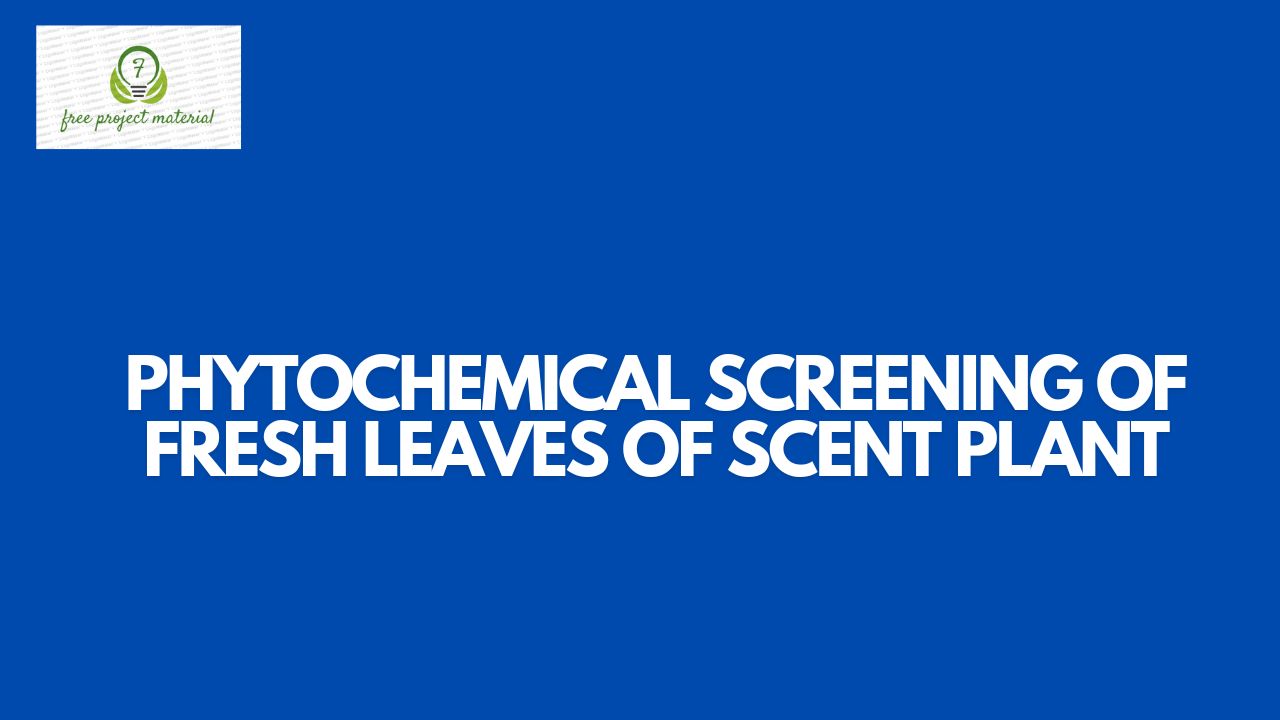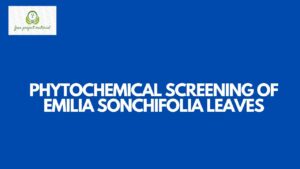ABSTRACT
The phytochemical screening of scent leaves was carried out using standard analytical method. The result of this study revealed that Flavonoid, Tannins, Cynogenic glycoside, Alkaloid (when using Scent leave), were highly present (+++), while Alkaloid (Tannin test) were moderately present (++) and Saponins was present in trace amount (++). This result suggests that the plant could serve as an important agent for the management and treatment of disease. The use of the plant for the antimicrobial and diuretic is recommended due to the high presence of saponins and tannins.
TABLE OF CONTENTS
Title page – – – – – – – – – i
Certification – – – – – – – – ii
Dedication – – – – – – – – – iii
Acknowledgement – – – – – – – – iv
Abstract – – – – – – – – – v
Table of Content – – – – – – – – vi
CHAPTER ONE: INTRODUCTION
1.1 Background of the Study – – – – – – 1
1.2 Aims and Objective of the Study – – – – 4
1.2.1 Aims – – – – – – – – – 4
1.2.2 Objectives – – – – – – – – – 4
1.3 Scope and Limitation of the Study – – – – 4
1.4 Definition of Terms – – – – – – 4
CHAPTER TWO: LITERATURE REVIEW
2.1 Botanical Description of Scent Plant – – – – 6
2.2 Distribution and Taxanomy of Scent Plant – – – 6
2.3 Traditional Uses of Scent Plant – – – – – 7
2.4 Phytochemistry of Scent Plant – – – – – 10
2.5 Pharmacological Importance of Scent Plant – – – 10
2.6 Phytochemical – – – – – – – 17
2.6.1 Flavonoid – – – – – – – – 17
2.6.2 Alkaloid – – – – – – – – 18
2.6.3 Tannins – – – – – – – – 19
2.6.4 Saponin – – – – – – – – 20
2.6.5 Cardia Glycoside – – – – – – – 22
CHAPTER THREE: MATERIALS AND METHODS
3.1 Reagents Used – – – – – – – 23
3.2 Collection and Preparation of Sample – – – – 23
3.3 Sample Extraction Method- – – – – – 23
3.4 Methods Used in Phytochemical Analysis – – – 24
3.4.1 Test for Alkaloids – – – – – – – 25
3.4.2 Test for Saponins – – – – – – – 25
3.4.3 Test for Flavonoids – – – – – – 25
3.4.4 Test for Tannins – – – – – – – 26
3.4.5 Test for Cardiac Glycoside – – – – – 26
CHAPTER FOUR: RESULTS AND DISCUSSION
4.1 Results – – – – – – – – 27
4.2 Discussion – – – – – – – – 28
CHAPTER FIVE: CONCLUSION AND RECOMMENDATIONS
5.1 Conclusion – – – – – – – – 31
5.2 Recommendations – – – – – – – 31
References
CHAPTER ONE: INTRODUCTION
1.1 Background of the study
The use of medicinal plants in traditional and complementary medicine for the treatment, management, or prevention of various diseases is as old as the origin of mankind (Yuan et al., 2016; Ekweogu et al., 2019). It has been estimated that approximately 80% of the world’s population depends mainly on ethno medicine or herbal medicine for the treatment of numerous diseases worldwide (Joshi, 2013; Pant, 2014). Interestingly, the increasing preference for the use of herbal medicines over conventional medicines may be attributed to the efficacies of the active ingredients present in herbal medicine to serve as natural healing agents as well as their availability, accessibility, affordability, and acclaimed lessor non-toxic effects (Ikpeazu et al., 2018; Ijioma et al., 2021).
Furthermore, over the last decade, medicinal plants and their bioactive compounds have attracted the attention of several researchers because of their usefulness in the management and prevention of life-threatening and chronic diseases (Sofowora et al., 2013; WHO, 2019) such as cancer, diabetes, stroke, and arthritis (Bernell and Howard, 2016), as an alternative therapy for the treatment of psychiatric disorders (Venuprasad et al., 2014), and in meeting the health requirements of the
Elderly (WHO, 2019). Currently, these medicinal plants have not only been employed in the treatment of numerous ailments, but also serve as a source of novel drugs for use in traditional or orthodox medicine. Drugs such as quinine, digoxin, aspirin, and morphine were produced from medicinal plants such as Cinchona officinalis, Digitalis purpurea, Saix alba, and Papaver somniferum, respectively (Mbanaso et al., 2020). discovered medicinal plants with the potential to serve as an alternative therapy for the treatment of various ailments or as a source of a new drug. It is a widespread and commercially viable perennial herbaceous plant with a very strong aromatic smell. It belongs to the family of Lamiaceae and is found in Africa, Asia, and South America (Tanko et al., 2008; Akara et al., 2021). It is used as a natural flavouring agent, condiment, or vegetable in the preparation of fish, meat, soup, and stew. It is also used in traditional medicine for the treatment of several ailments such as cough, pneumonia, fever, inflammation, anaemia, diarrhoea, pains, and fungal and bacterial infections (Akara et al., 2021).
Scientific reports have shown that O. gratissimum has a wide range of bioactive compounds such as flavonoids and polyphenols (Venuprasad et al., 2014; Irondi et al., 2016) and essential oils with several beneficial effects (Benitez et al., 2009; Melo et al., 2019), Furthermore, several studies have shown this plant possesses numerous pharmacological properties such as anti-hyperglycaemic (Aguiyi et al., 2000; Casanova et al., 2014), hypoglycaemic (Shittu et al., 2019), anti-inflammatory (Ajayi et al., 2019), anti-diarrhoeal (Offiah and Chikwendu, 1999), anti-anaemic, hepatoprotective (Akara et al., 2021), anti-hypertensive (Shaw et al., 2017), antibacterial (Melo et al., 2019), antifungal (Mohr et al., 2017), and anti-oxidative properties (Joshi, 2013; Mahapatra and Roy, 2014) as well as exhibits many other pharmacological activities.
1.2 Aim and Objective of the study
1.2.1 Aim
The aim of this research work is assess the phytochemical screening of fresh leaves of scent plant.
1.2.2 Objective
- To assess the phytochemical present in scent leaves.
- To highlight the usefulness of these phytochemical compounds to orthodox medicine practitioners and pharmaceutical companies.
- To make recommendation base on the result of this research.
1.3 Scope and Limitation of the study
This project is to Assess the phytochemical present in scent leaves and due to the limited time assigned for this research, as well as financial constraint of the researcher, the work was limited to only the leaves of scent plant.
1.4 Definition of terms
Phytochemicals: are chemicals from plant origin
Flavonoids: flavonied are plant metabolites classified as polyphenolic that are ubiquitous in nature. They are collective known as
Saponins: referred to selectively as triterpene glycosides, they are bitter- tasting usually toxic plant-derived from organic chemicals that have a foamy quality when agitated in water.
Tannin: is an astringent, polyphenolic biomolecule that binds to and precipates proteins and various other organic compounds including amino acids.
Alkaloids: are bitter-tasting chemicals, very widespread in nature, and often toxic, found in many medicinal plants.
Phytochemical screening: This is a method often used in detecting the presence of phytochemical compounds in plant samples.



